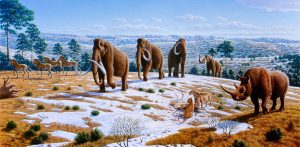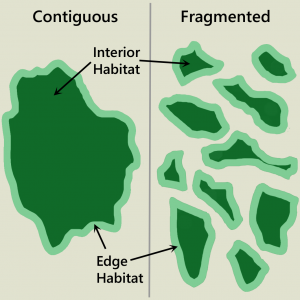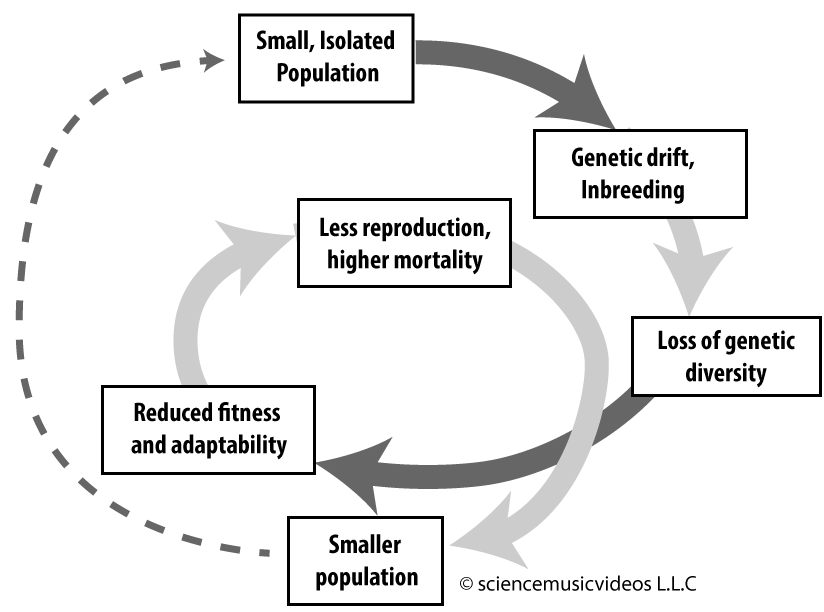1. Introduction
Congratulations! You’ve reached the last topic in Learn-Biology.com’s AP Bio curriculum.
Since biology is the study of life, it’s fitting that we should end by looking at the impact that our species is having on the living world. Only by understanding that impact will we humans be able to create a healthy, sustainable environment for generations to come, and for the other species with whom we share our planet.
2. Welcome to the Anthropocene Age and the Sixth Extinction

For as long as we’ve been a species, we humans have caused significant changes to the environment.
Even before agriculture, when humans lived as nomadic hunter-gatherers, we never lived in peaceful harmony with the environment. As humans spread from Africa to populate the rest of the world, waves of extinctions of megafauna (large animals including woolly mammoths, mastodons, and giant sloths) quickly followed. When we spread to Europe, most European megafauna became extinct. When we spread to North America, most North American megafauna became extinct. Why? Almost certainly because of overhunting.
As our population and technological prowess have grown, so has our impact. According to many geologists, we’re now living in the Anthropocene Age.
- The root “anthropo-” refers to humans, as in “anthropology.”
- The suffix “-cene” denotes a geological age).
To say that we’re living in the Anthropocene is to say that humans have become the dominant biological force on the planet. If you include our effects on the atmosphere, such as emitting gases like carbon dioxide and methane that are warming our planet and altering the water cycle, then we’ve become a geological force, too.
Starting with the industrial revolution that began in the early 1800s, human activity has been causing what’s called the Sixth Mass Extinction. During mass extinctions, a large number of species go extinct in a relatively short geological time period. These events are usually caused by major environmental changes, such as massive volcanic eruptions, climate shifts, or asteroid impacts. But the Sixth Extinction is on us.
Note that “mass extinction” was dropped from the AP Bio curriculum in the College Board’s most recent Course and Exam description. But you can still learn about them through this tutorial on Learn-Biology.com.
Let’s see what we’ve done (and are doing).
3. Destruction and alteration of habitat
A habitat is the natural environment where an organism lives and grows. It provides the food, water, shelter, and other conditions the organism needs to survive and reproduce.
Species evolve to survive and reproduce in a particular habitat. Due to human activity, many habitats are becoming degraded or are disappearing, causing the non-human species that lived in that habitat to flee or perish. In a 2012 report by the Geological Society of America, Roger Hooke and Jose Martin Duque estimated that humans have modified more than 50% of the Earth’s land surface, which has destroyed, altered or modified the habitats that were formally in those areas.
What kind of modifications are we talking about?
- Development of housing and urban areas, commercial and industrial areas, and developed recreation areas (golf courses, skiing areas, etc. )
- Agriculture (farming) and aquaculture (farming the seas).
- Energy production and mining. Mining for coal, which can involve the removal of entire mountain tops, is particularly destructive.
- Fishing methods such as bottom trawling for shellfish or dredging. These types of fishing drag nets along the ocean floor, damaging or destroying whatever they encounter.
- Forestry methods such as clear-cutting.
- Natural system modification that changes habitats. This includes
- Fire suppression and/or increasing fire frequency
- Damming rivers
Some of the activities above — extensive clear cutting, fishing by dredging, or mountain top removal for coal — are particularly destructive and shouldn’t be allowed. At the same time, people need houses, food, materials, energy, and so on. To create a sustainable future, humans need to figure out how to balance our economic needs with:
- Our need to maintain the planetary systems that provide us with the air, water, topsoil, climate and other amenities upon which our civilization depends.
- Our desire to promote the survival of the other species with whom we share the planet.
If an animal or plant species is endangered or threatened, habitat loss or degradation is the most likely cause. 80% of all threatened birds are experiencing habitat loss or degradation. The same is true for 83% of all threatened mammals, and 91% of all threatened plants.
4. Habitat Fragmentation
4a. What is Fragmentation?
[qwiz qrecord_id=”sciencemusicvideosMeister1961-What is fragmentation? (v2.0)”]
[h]What is fragmentation?
[q]Imagine that you’re a forest manager. One of your goals is to maintain the biodiversity of your forest. But you’re also responsible for harvesting timber. To meet your goals, you can choose to create one large, undisturbed reserve, and harvest the timber outside of it. This is what’s labeled as “contiguous” below. Or you could create many smaller reserves. This is labeled as”fragmented.” Note that the green area in both panels has the same area.
Which situation would help you to best meet both goals: harvesting timber and maintaining biodiversity?
[c]IFNob3cgbWUgdG hlIGFuc3dlcg==[Qq]
[f]IOKAiklmIHlvdXIgYW5zd2VyIHdhcyAmIzgyMjA7Y29udGlndW91cyYjODIyMTsgeW91IG1hZGUgdGhlIHJpZ2h0IGNob2ljZS4gUmVhZCBiZWxvdyB0byBsZWFybiB3aHku[Qq]
[/qwiz]
In addition to destroying or degrading habitat, one of the main ways that humans have affected the environment has been to fragment it into discontinuous, unconnected pieces. For any non-flying species, any difficult-to-cross highway will cut their territory into separate fragments. Even flying species like bats and birds might refrain from flying from an enclosed habitat (like a forest) through open territory to get to the next bit of forest.
Fragmentation causes several problems for the species living in these fragments.
4b. Fragmentation results in areas that are too small for populations to maintain themselves
Depending on its ecological niche, any population of a species needs a certain amount of area to maintain itself. For top-level carnivores, the sustainable amount of area can be enormous. A pride of lions, for example, needs 20 square kilometers to maintain itself when prey is abundant. If the prey is scarce, that same pride might need 400 square km. (source: Britannica). A wolf pack needs 500-1300 square kilometers to sustain itself (US Fish and Wildlife Service) As a result, creating non-fragmented, contiguous reserves that can support top level carnivores can be difficult.
4c. Fragmentation causes population bottlenecks
To avoid a population bottleneck that leads to loss of genetic diversity, populations need to 1) maintain themselves above a certain minimum level, and 2) exchange genes with neighboring populations. To stick with the example of lions, an area with only one or two prides is prone to a population bottleneck where random genetic drift will cause each small population to lose genetic diversity. To prevent that, each pride needs its territory to adjoin with an adjacent pride’s territory. This allows for genes to flow between prides, and keeps each pride from suffering from inbreeding. In an isolated fragment, that’s exactly what happens: populations experience a bottleneck that leads to inbreeding and loss of genetic diversity through genetic drift.
4d. Fragmentation causes the Edge Effect
 The boundary of any natural area has an edge, and the environment at the edge is often quite different from the environment in the interior. As you can see on the left, fragmented areas have much more edge habitat. This habitat experiences much more disturbance, which creates stress for the organisms living at the edge.
The boundary of any natural area has an edge, and the environment at the edge is often quite different from the environment in the interior. As you can see on the left, fragmented areas have much more edge habitat. This habitat experiences much more disturbance, which creates stress for the organisms living at the edge.
One of the largest studies of the edge effect is the Biological Dynamics of Forest Fragments Project. This project, set in Brazil’s Amazon rainforest, involves dozens of study fragments of different sizes, along with undisturbed areas of equal size deep within undisturbed tracts of forest. These fragments and the control areas have been studied for over 40 years.
The following passage is an example of what researchers found. (source: Brazil’s Fragmented Forests).
The open flank of a newly created clearing leaves the remaining forest more vulnerable to wind and weather. Wind shear and turbulence forces on the forest edge lead to higher tree mortality. Desiccation caused by the inferior water retention capacity of the clearing adds to the damage…Research has shown that the drier air above a clearing can then suck the moisture out of the adjoining forest and cause desiccation penetrating hundreds of meters deep into the forest. Recent satellite measurements of moisture in the canopy even indicate that the effects can still be felt 2.7 kilometers away from the nearest forest edge.
4e. Fragmentation and the Extinction Vortex

When a population is stuck in a fragment of insufficient size, it can get sucked down into a death spiral called the extinction vortex. A whirlpool above a drain is an example of a vortex. In the same way that a vortex pulls water down a drain, an extinction vortex pulls a population toward extinction. The extinction vortex works like this:
- Ecological disturbances make it difficult for a species to successfully exploit its niche. As a result, there’s a decrease in the population size. Fragmentation increases the chance that the population will be isolated.
- This lowered size leads to genetic drift, which decreases genetic variability.
- Decreased variability makes the population less fertile and less able to adapt to change.
- Additional disturbances lead to further population decline.
Though obviously a bad thing, an extinction vortex is a positive feedback loop that builds its own momentum. Positive feedback loops with negative consequences are often called vicious cycles. Species that enter this vicious cycle often quickly decline toward extinction.
5. Disruption of Ecosystems Quiz 1
[qwiz qrecord_id=”sciencemusicvideosMeister1961-Disruption of Ecosystems Quiz 1 (v2.0)”]
[h]Disruption of Ecosystems Quiz 1
[i]
[q]Because of humanity’s ongoing impact upon the Earth’s systems, the current age has come to be known as the [hangman]
[c]YW50aHJvcG9jZW5l[Qq]
[q]Loss of biodiversity caused by human activities is giving rise to the Earth’s sixth [hangman] [hangman].
[c]bWFzcw==[Qq]
[c]ZXh0aW5jdGlvbg==[Qq]
[q]Development of cities, farms, and recreation areas has destroyed wildlife [hangman].
[c]aGFiaXRhdA==[Qq]
[q labels = “top”]If an animal or plant is ______________ or threatened, ____________ loss or ______________ is the most likely cause. Note that the problem isn’t development in and of itself. The problem is the _____________ to which development has modified the surface of the Earth: up to 50% of the Earth’s surface has been in someway ___________ by human activity.
[l]degradation
[fx] No, that’s not correct. Please try again.
[f*] Excellent!
[l]endangered
[fx] No. Please try again.
[f*] Correct!
[l]extent
[fx] No. Please try again.
[f*] Good!
[l]habitat
[fx] No, that’s not correct. Please try again.
[f*] Great!
[l]altered
[fx] No. Please try again.
[f*] Great!
[q]Habitat [hangman] occurs when humans divide wildlife habitat into discontinuous, unconnected pieces.
[c]ZnJhZ21lbnRhdGlvbg==[Qq]
[q]Particularly for [hangman] species like wolves and lions that are at the top of the [hangman] [hangman], the problem with fragmentation is that the remaining area can be insufficient for these animals to find enough prey to sustain themselves
[c]cHJlZGF0b3J5[Qq]
[c]Zm9vZA==[Qq]
[c]Y2hhaW4=[Qq]
[q]Fragmentation also leads the populations trapped within the fragment to experience a population [hangman]. Without [hangman] flow from adjacent populations, each isolated population will experience [hangman] drift, leading to a loss of genetic [hangman].
[c]Ym90dGxlbmVjaw==[Qq]
[c]Z2VuZQ==[Qq]
[c]Z2VuZXRpYw==[Qq]
[c]ZGl2ZXJzaXR5[Qq]
[q]Assume that the two images below represent proposed nature reserves. The problem with proposal 2 is that the four combined fragments will have much more [hangman] habitat than proposal 1. This habitat will be unsuitable for species that require an environment that’s only available in the interior. As a result, you can predict that overall [hangman] will be lower in proposal 2. In addition, the populations in each fragment in proposal 2 will be smaller, subjecting them to more genetic [hangman].
[c]ZWRnZQ==[Qq]
[c]YmlvZGl2ZXJzaXR5[Qq]
[c]ZHJpZnQ=[Qq]
[q labels = “top”]Small populations can also become trapped in a disastrous __________ feedback loop called an ____________ _________. In this situation, small size leads to a lack of _________ diversity, which reduces ________, which lowers the rate of ________________, which further reduces population size.
[l]extinction
[fx] No, that’s not correct. Please try again.
[f*] Excellent!
[l]fitness
[fx] No, that’s not correct. Please try again.
[f*] Great!
[l]genetic
[fx] No. Please try again.
[f*] Excellent!
[l]positive
[fx] No, that’s not correct. Please try again.
[f*] Great!
[l]reproduction
[fx] No, that’s not correct. Please try again.
[f*] Excellent!
[l]vortex
[fx] No, that’s not correct. Please try again.
[f*] Excellent!
[x]
[/qwiz]
6. What’s Next
Proceed to Disruption to Ecosystems Part 2: Overharvesting, Overhunting, and Introduced Species
